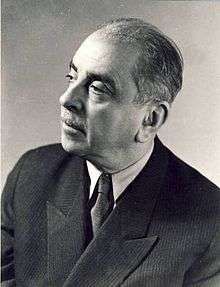Simion Stoilow
Simion Stoilow or Stoilov (14 September [O.S. 2 September] 1887 – 4 April 1961)[1] was a Romanian mathematician, creator of the Romanian school of complex analysis, and author of over 100 publications.
Simion Stoilow | |
|---|---|
 | |
| Born | 14 September 1887 |
| Died | 4 April 1961 (aged 73) |
| Nationality | Romanian |
| Alma mater | University of Paris |
| Known for | Complex analysis |
| Awards | Kerékjártó-Stoilow compactification Iversen-Stoilow surface |
| Scientific career | |
| Fields | Mathematics |
| Institutions | University of Bucharest |
| Thesis | Sur une classe de fonctions de deux variables définies par les équations linéaires aux dérivées partielles (1916) |
| Doctoral advisor | Émile Picard |
| Doctoral students | Cabiria Andreian Cazacu |
Biography
He was born in Bucharest, and grew up in Craiova. His father, Colonel Simion Stoilow, fought at Smârdan in the Romanian War of Independence. After studying at the Obedeanu elementary school and the Carol I High School, Stoilow went in 1907 to the University of Paris, where he earned a B.S. degree in 1910 and a Ph.D. in Mathematics in 1916. His doctoral dissertation was written under the direction of Émile Picard.[2]
He returned to Romania in 1916 to fight in World War I's Romanian Campaign, first in Dobrudja, then in Moldavia. After the war, he became professor of mathematics at the University of Iaşi (1919–1921) and the University of Cernăuţi (1921–1939). He was an Invited Speaker of the International Congress of Mathematicians in 1920 at Strasbourg, in 1928 at Bologna, and in 1936 at Oslo. In 1939 he moved to Bucharest, working first at the Polytechnic University of Bucharest, and from 1941 at the University of Bucharest, serving as rector from 1944 to 1946 and as dean of the Faculties of Mathematics and Physics from 1948 to 1951.
From 1946 to 1948, he served as Romanian ambassador to France. In 1946 he was a member of the Romanian delegation at the Paris Peace Conference, headed by Gheorghe Tătărescu. In July 1947 he organized at Club de Chaillot the exhibit "L'art français au secours des enfants roumains"; Constantin Brâncuși participated, Tristan Tzara and Jean Cassou wrote the preface to the catalogue.
Stoilow was elected corresponding member of the Romanian Academy in 1936, and full member in 1945, and later became president of the Physics and Mathematics section of the Academy.[1] In 1949 he was the founding director of the Institute of Mathematics of the Romanian Academy, serving in that capacity until he died. Among his students at the University of Bucharest and at the Institute were Cabiria Andreian Cazacu, Romulus Cristescu, Martin Jurchescu, Ionel Bucur, and Aristide Deleanu,[2] as well as Nicolae Boboc, Corneliu Constantinescu, and Aurel Cornea.
Stoilow died in Bucharest in 1961 of a brain stroke. He was cremated at the Cenuşa crematorium. Prior to the Romanian Revolution of 1989, his funeral urn was maintained in a crypt at the Carol Park Mausoleum.
Legacy
The Institute of Mathematics of the Romanian Academy (closed in 1975 by a decree of Nicolae Ceauşescu, reopened in the immediate aftermath of the Romanian Revolution of 1989), is now named after him. The Simion Stoilow Prize is awarded every year by the Romanian Academy.
Work
- Siméon Stoilow (1916). Sur une classe de fonctions de deux variables définies par les équations linéaires aux dérivées partielles (PDF) (Thesis). VI u. 84 S. 4. Paris: Gauthier-Villars. JFM 46.1481.03.
- Siméon Stoïlow (1919). "Sur les singularités mobiles des intégrales des équations linéaires aux dérivées partielles et sur leur intégrale générale" (PDF). Annales Scientifiques de l'École Normale Supérieure. (3). 36: 235–262. doi:10.24033/asens.717. JFM 47.0946.01.
- Simion Stoïlow, "Leçons sur les principes topologiques de la théorie des fonctions analytiques", Gauthier-Villars, Paris, 1956. MR0082545[3]
- Simion Stoïlow, "Œuvre mathématique", Éditions de l'Académie de la République Populaire Roumaine, Bucharest, 1964. MR0168435
References
- O'Connor, John J.; Robertson, Edmund F., "Simion Stoilow", MacTutor History of Mathematics archive, University of St Andrews.
- Simion Stoilow at the Mathematics Genealogy Project
- Whitney, Hassler (1938). "Review: "Leçons sur les principes topologiques de la théorie des fonctions analytiques", by S. Stoïlow" (PDF). Bulletin of the American Mathematical Society. 44 (11): 758–759. doi:10.1090/s0002-9904-1938-06867-X.
- Cabiria Andreian Cazacu, "Sur l'œuvre mathématique de Simion Stoïlow", pp. 8–21, Lecture Notes in Mathematics, vol. 1013, Springer-Verlag, Berlin, 1983. MR0738079
- "Analysis and Topology: A Volume Dedicated to the Memory of S. Stoilow", edited by Cabiria Andreian Cazacu, Olli Lehto, and Themistocles M. Rassias, World Scientific Publishers, 1998. ISBN 981-02-2761-2
External links
- Short biography
- (in Romanian) Short biography
- (in Romanian) Short biography, at Obedeanu school
- Brâncuși exhibits